Perihal SARAWAK - BUMI KENYALANG
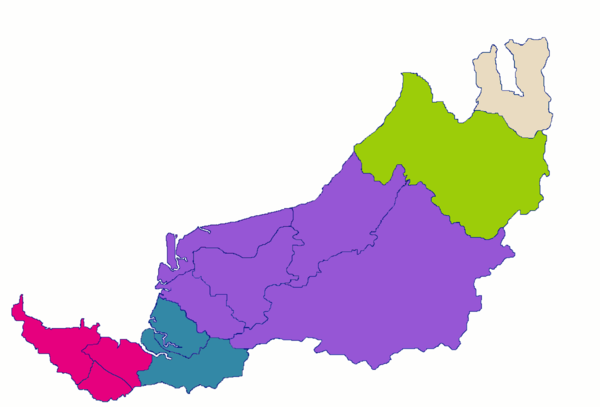
Sarawak
From Wikipedia, the free encyclopedia
For the river, see Sarawak River. For the ship, see HMS Sarawak (K591).
| Sarawak | |||
|---|---|---|---|
| State | |||
| Bumi Kenyalang (Land of the Hornbills) | |||
|
|||
| Nickname(s): Land of the Hornbills | |||
| Motto: "Bersatu, Berusaha, Berbakti" "United, Striving, Serving" |
|||
| Anthem: Ibu Pertiwiku (My Motherland) | |||
 |
|||
| Capital | Kuching | ||
| Divisions | |||
| Government | |||
| • Yang Di-Pertua Negeri | Tun Pehin Sri Abdul Taib Mahmud | ||
| • Chief Minister | Tan Sri Datuk Patinggi Adenan Satem (BN) | ||
| Area[3] | |||
| • Total | 126,448.41 km2 (48,822.00 sq mi) | ||
| Population (2010)[4] | |||
| • Total | 2,420,009 | ||
| • Density | 19/km2 (50/sq mi) | ||
| Demonym(s) | Sarawakian | ||
| Human Development Index | |||
| • HDI (2010) | 0.692 (high) (11th) | ||
| Time zone | MST[5] (UTC+8) | ||
| Postal code | 93xxx[6] to 98xxx[7] | ||
| Calling code | 082 (Kuching), (Samarahan) 083 (Sri Aman), (Betong) 084 (Sibu), (Kapit), (Sarikei), (Mukah) 085 (Miri), (Limbang), (Marudi), (Lawas) 086 (Bintulu), (Belaga)[8] |
||
| Vehicle registration | QA & QK (Kuching) QB (Sri Aman) QC (Kota Samarahan) QL (Limbang) QM (Miri) QP (Kapit) QR (Sarikei) QS (Sibu) QT (Bintulu) QSG (Sarawak State Government)[9] |
||
| Brunei Sultanate | 15th century–1841[10] | ||
| Brooke dynasty | 1841–1946 | ||
| Japanese occupation | 1941–1945 | ||
| British Crown Colony | 1946–1963 | ||
| Self-government | 22 July 1963[11][12][13][14] | ||
| Malaysia Agreement[15] | 16 September 1963a[16] | ||
| Website | www.sarawak.gov.my | ||
| a Despite the fact that the Federation of Malaysia only came into existence on 16 September 1963, 31 August is celebrated as the Independence day of Malaysia. Since 2010, 16 September is recognised as Malaysia Day, a patriotic national-level public holiday to commemorate the foundation of Federation of Malaysia that joints North Borneo, Malaya, Sarawak and (previously) Singapore as equal partners of the federation.[17] | |||
Sarawak is situated on the northwest of Borneo, bordering the state of Sabah to the northeast, Indonesia to the south, and surrounding the independent state of Brunei. The administrative capital is Kuching, which has a population of 700,000.[18] Major cities and towns include Miri (pop. 350,000), Sibu (pop. 257,000) and Bintulu (pop. 200,000). As of the last census (2010), the state population was 2,420,009.[4]
Contents
History
Bruneian Empire
A west view of a river from the anchorage off Sarawak, Borneo circa 1800s. Painting from the National Maritime Museum of London.
Brooke Dynasty
Main articles: Kingdom of Sarawak and White Rajahs
An 1888 postage stamp of Sarawak featuring the picture of Charles Brooke.
In the early part of 1941, preparations were afoot to introduce a new constitution, designed to limit the power of the Rajah and give the people of Sarawak a greater say in government. Despite this democratic intention, the draft constitution contained irregularities, including a secret agreement drawn up between Charles Vyner Brooke and his top government officials, financially compensating him via treasury funds.[14]
Second World War and occupation
Main article: Japanese occupation of British Borneo
Japan invaded Sarawak and occupied the island of Borneo in 1941,
occupying Miri on 16 December and Kuching on 24 December, holding both
territories for the duration of World War II until the area was secured by Australian forces in 1945 and managed under the British Military Administration. Charles Vyner Brooke formally ceded sovereignty to the British Crown
on 1 July 1946, under pressure from his wife among others. In addition,
the British Government offered a healthy pension to Brooke. Anthony
Brooke, the designated heir, opposed the cession of the Rajah's
territory to the British Crown, and was associated with anti-cessionist
groups in Sarawak, consisting of a majority of the native members of the
Council Negri (Parliament).Post-Japanese Occupation
Main articles: Crown Colony of Sarawak and Anti-cession movement of Sarawak
Tan Sri Datuk Amar Stephen Kalong Ningkan declaring the forming of the Federation of Malaysia on 16 September 1963.
Self-government and the Federation of Malaysia
See also: Sarawak Self-government Day and Sarawak Communist Insurgency
Sarawak was officially granted self-government on 22 July 1963,[11][12][13] and later formed the federation of Malaysia with Malaya, North Borneo, and Singapore on 16 September 1963,[22][23] despite the initial opposition from parts of the population.[24][25] Sarawak was also a flashpoint during the Indonesia–Malaysia confrontation between 1962 and 1966.[26][27] Between 1962 and 1990, there was also a Communist insurgency in Sarawak.[28]Geography
Kuching is the capital of Sarawak and lies along the Sarawak River. On the left is the State Legislative Assembly Building.
The state of Sarawak stretches for over 750 kilometres (466 mi) along the northeast coastline of Borneo, interrupted in the north by about 150 kilometres (93 mi) of Bruneian coast. Should Brunei not be taking up Sarawak's coast, the entire coastline of Sarawak would be 900 kilometres (559 mi) long. Sarawak is separated from the Indonesian part of Borneo (Kalimantan) by ranges of high hills and mountains that are part of the central mountain range of Borneo. These get higher to the north and culminate near the source of the Baram River with the steep Mount Selidang (4504 ft) at central plateau of Usun Apau, Mount Batu Lawi, Mount Mulu in the park of the same name and Mount Murud with the highest peak in Sarawak.
The major rivers from the south to the north include the Sarawak River, Lupar River, Saribas River, and Rajang River, which is the longest river in Malaysia at 563 kilometres (350 mi). The Baleh River branch, the Baram River, and the Limbang River drains into the Brunei Bay as it divides the two parts of Brunei and the Trusan River. The Sarawak river is 2,459 square kilometres (949 sq mi) in area and is the main river flowing through the capital of Kuching.
Sarawak can be divided into three natural regions. The coastal region is rather low lying flat country with large extents of swamps and other wet environments. The hill region provides most of the easily inhabited land and most of the larger cities and towns have been built in this region. The ports of Kuching and Sibu have been built some distance from the coast on rivers. Bintulu and Miri are close to the coastline where the hills stretch right to the South China Sea. The third region is the mountain region along the border and with the Kelabit (Bario), Murut (Ba Kelalan) and Kenyah (Usun Apau) highlands in the north.
Demographics
Main article: Demographics of Sarawak
Population
As of the 2010 census, the population of Sarawak was 2,399,839, making it the 4th most populous state in Malaysia.[29] Due to the large area of Sarawak, it has the lowest population density in Malaysia, which stands at 22 people per km2. Sarawak also has some of the lowest population growth in Malaysia.Ethnic groups
Sarawak has more than 40 sub-ethnic groups, each with its own distinct language, culture and lifestyle. Cities and larger towns are populated predominantly by Malays, Melanaus, Chinese, Indians, and a smaller percentage of Ibans and Bidayuhs who have migrated from their home villages to look for employment.Generally, Sarawak has six major ethnic groups namely Iban, Chinese, Malay, Bidayuh, Melanau, and Orang Ulu.[30] Several minor ethnic groups include Kedayan, Javanese, Bugis, Murut, and Indian. Unlike Indonesia, the term Dayak is not officially used to address Sarawakian's native ethnicity.
Iban
Main article: Iban people
A traditional Iban longhouse.
The large majority of Ibans practise Christianity. However, like most other ethnic groups in Sarawak, they still observe many of their traditional rituals and beliefs. Sarawak celebrates colourful festivals such as the generic Gawai Dayak (Harvest Festival), Gawai Kenyalang (Hornbill Festival), Gawai Burong (Bird Festival), Gawai Tuah (Luck Festival), Gawai Pangkong Tiang (House Post Banging Festival), Gawai Tajau (Jar Festival), Gawai Sakit (Healing Festival) and Gawai Antu (festival of the dead).
Chinese
Main article: Malaysian Chinese
A Chinese paifang in Kuching.
The Sarawak Chinese belong to a wide range of dialect groups, the most significant being Cantonese, Foochow, Hakka, Hokkien, Teochew, Hainanese, and Puxian Min. The Chinese maintain their ethnic heritage and culture and celebrate all the major cultural festivals, most notably the Chinese New Year and the Hungry Ghost Festival. The Sarawak Chinese are predominantly Buddhists.
Ethnic Chinese were encouraged to settle in Sarawak because of their commercial and business acumen. The biggest dialect group is the Hokkien people; many originated from Choanchew, Chiangchew, Longhai, Kinmen, Amoy and Taiwan.
The Hakka people, Teochew people, Henghua people, Hainan people, Shanghainese people and Cantonese people represent a minority of the Chinese population. Despite their small numbers, the Hokkien have a considerable presence in Sarawak's private and business sector, providing commercial and entrepreneurial expertise and often operating joint business ventures with Malaysian Chinese entreprises.[31] A notable person namely Ong Tiang Swee safeguard the interest and welfare of the Chinese communities in Sarawak back in the old days, he was considered as Kapitan China.
In 1963, when Sarawak helped Malaya to form Malaysia, most of the Chinese which hails from Coastal cities from Xiamen, Guangzhou, Quanzhou automatically gained Malaysian citizenship despite having the Republic of China citizenship under Kuomintang (not to be confused with Communist Party of China).[32]
Fuzhou people came in Sarawak in 1901 from Fuzhou, Fujian due to numerous violent incident such as the infamous Boxer Rebellion that occurred in the Qing Dynasty in 1899.[33] During the boxer rebellion many Chinese Christian were brutally murdered, and women and children were being punished for their faith, as of this action the Qing Dynasty supported the causes, Wong Nai Siong a Christian leader, led them to a safer place to live and to create a community by agreeing with terms and contract with late Charles Brooke, Rajah of Sarawak and later allocated them to a nearby town called Sibu and decided to name it the New Foochow Settlement. However, due to the sizeable presence of other Chinese sub-ethnic groups such as the Hokkiens, Hakka, and the Cantonese they ultimately retained the original name of the area.[34]
Sarawak Hakka were particularly from Jiexi County, Guangdong. As most of these Hakka spoke Hopo Hakka which differs from the other Hakka.
Malay
Main article: Sarawak Malay
A Sarawak Malay traditional house.
Melanau
Main article: Melanau
The Melanaus have been thought to be amongst the original settlers of Sarawak.[36] They make up 6% of the population in Sarawak.[29]Today most of the Melanaus community profess Islam and Christianity, though they still celebrate traditional animist festivals such as the annual Kaul festival.
Bidayuh
Main article: Bidayuh
Concentrated mainly on the West end of Borneo, the Bidayuhs make up 8% of the population in Sarawak.[29]The Bidayuhs speak a number of different but related dialects. Some Bidayuhs speak either English or Sarawak Malay as their main language. While some of them still practise traditional religions, the majority of modern-day Bidayuhs have adopted the Christian faith. Another ethnic associated to Bidayuh is Salako, classified as Bidayuh by the Malaysian government for political convenience.
Orang Ulu
Main article: Orang Ulu
Orang Ulu is an ethnic group in Sarawak. The various Orang Ulu
ethnics together make up roughly 6% of Sarawak's population. The phrase Orang Ulu
means upriver people and is a term used to collectively describe the
numerous tribes that live upriver in Sarawak's vast interior. Such
groups include the major Kenyah
and Kayan people, and the smaller neighbouring groups of the Kajang,
Kejaman, Punan, Ukit, and Penan. Nowadays, the definition also includes
the down-river tribes of the Lun Bawang, Lun Dayeh, "mean upriver" or "far upstream", Berawan, Saban as well as the plateau-dwelling Kelabits. Orang Ulu
is a term coined officially by the government to identify several
ethnics and sub-ethnics who live mostly at the upriver and uphill areas
of Sarawak. Most of them live in the district of Baram, Miri, Belaga, Limbang, and Lawas.A vast majority of the Orang Ulu tribe are Christians but traditional religions are still practised in some areas.
Some of the major tribes making up the Orang Ulu group include:
Others
Other minority ethnic groups residing in Sarawak are the Kedayan ethnic groups and also the Punan Bah people (in fact is a collective of obscure and unaccounted ethnic communities grouped together as a single ethnic entity), and also non-Bumiputera ethnic groups, which are the Indian and Eurasian.The Kedayan are an ethnic group residing in parts of Sarawak. The Kedayan language is spoken by more than 37,000 people in Sarawak, with most of the members of the Kedayan community residing in Lawas, Limbang, Miri, and Sibuti areas. Unlike its Peninsular counterpart, Sarawakians of Indian descent are small in number and have assimilated very well to the other communities. Eurasians continues to be the smallest among the minority ethnic groups in Sarawak, mostly due to assimilation and interracial marriages. The Punan Bah communities are usually located in areas that encompass the borders of Sarawak, Sabah, Brunei, and Indonesia. More studies need to be carried out about them, as they are one of the lesser known group in the state.
Religion
Main article: Demographics of Sarawak § Religions of Sarawak
As of 2010 the population of Sarawak disregarding foreign immigrants is 44.0% Christian, 30.0% Muslim, 13.5% Buddhist, 6.0% Taoist or Chinese religion follower, 3.1% follower of other religions, and 2.6% non-religious.Sarawak is the only state in Malaysia where Christians outnumber Muslims. Major Christian denominations in Sarawak are the Roman Catholics, Anglicans, Methodists, Borneo Evangelical Mission (BEM or Sidang Injil Borneo, S.I.B.), and Baptists. Many Sarawakian Christians are non-Malay Bumiputera, ranging from Iban, Bidayuh, Orang Ulu and Melanau. Islam is the second largest religion in Sarawak. Many Muslims are from Malay, Melanau, and Kedayan ethnic groups. Buddhism is the third largest, predominantly practised by Chinese Malaysians. Taoism and Chinese Folk Religion are together the fourth largest religious group, also represented by ethnic Chinese. Other minor religions in Sarawak are Baha'i, Hinduism, Sikhism, and animism. Many Dayaks especially the Ibans, continue to practice their ethnic religion, particularly with dual marriage rites and during the important harvest and ancestral festivals such as Gawai Dayak, Gawai Kenyalang and Gawai Antu. Other ethnics who have trace number of animism followers are Melanau and Bidayuh.
Government
The parliament of Sarawak is the Sarawak State Legislative Assembly.Politics of Sarawak
Timeline of political parties in Sarawak.
Sarawak has been a political stronghold of ruling Alliance Party and later Barisan Nasional (BN) coalition since its independence in 1963. Stephen Kalong Ningkan (SNAP) was the first Chief Minister of Sarawak from 1963 to 1966 following his landslide winnings of three tier system of local authority elections. He was later ousted in 1966 by Tawi Sli (PESAKA) with the help of Malaysian federal government, causing 1966 Sarawak constitutional crisis.[38]
Sarawak political climate was stable since then until the Ming Court Affair which lasted from 1987 to 1991. Ming Court Affair was a political coup initiated by Abdul Taib Mahmud's uncle in order to topple the Taib led Sarawak BN coalition. However, the coup was unsuccessful and Taib was able to retain his chief minister post.[39] The issue of human rights of Penan and deforestation in Sarawak became an international environmental issue when Swiss activist Bruno Manser entered Sarawak from 1984 until 2000 where he brought himself into direct conflict with the Sarawak state government.[40]
The year 1970 saw the completion the first Sarawak state election where members of Council Negri (now Sarawak State Legislative Assembly) was directly elected by the voters. This election also marks the beginning of ethnic Melanau domination in Sarawak politics at first by Abdul Rahman Ya'kub and followed by his nephew Abdul Taib Mahmud. In the same year, North Kalimantan Communist Party (NKCP) was formed which mounted guerilla warfare against the newly elected Sarawak state government. The party was dissolved after the signing of peace agreement in 1990.[28] The year 1973 saw the demise of SCA after it was booted out by the government coalition and the birth of Parti Pesaka Bumiputera Bersatu (PBB).[41] PBB was formed by the merger of three parties namely PANAS, BARJASA, and PESAKA. This party would later become the backbone of Sarawak BN coalition, currently holding 35 out of 71 state assembly seats after 2011 Sarawak state election.
A splinter party named Parti Bansa Dayak Sarawak (PBDS) broke off from SNAP in 1983 due to leadership tussle. PBDS would later dissolved in 2004 also due to another leadership crisis. Parti Rakyat Sarawak (PRS), a splinter party from PBDS, was formed after that in 2004. PRS is currently a component party in Barisan Nasional (BN). SNAP was deregistered in 2002. Sarawak Progressive Democratic Party (SPDP), another splinter party from SNAP, was formed after that in 2002 which would later become a component party of BN. The SNAP deregistration would later be reversed by Court of Appeal in June 2010. However, the revival was short-lived. SNAP was deregistered again in January 2013 by the verdict of Federal Court of Malaysia.[42] In 2010, another splinter party named Sarawak Workers Party (SWP) emerged to absorb dissidents from PRS. In 2014, Parti Tenaga Rakyat Sarawak (Teras) was formed following a split in SUPP, a component party in BN coalition.[43]
In 1978, Democratic Action Party (DAP) was the first Peninsular-based party to open its branches in Sarawak.[41] This party derived majority of its support from urban centres such as Miri, Bintulu, Sibu, and Kuching since 2006 state election and become the largest opposition party in Sarawak, currently holding 12 out of 71 state assembly seats.[44] In 2010, it forms Pakatan Rakyat coalition with Parti Keadilan Rakyat (PKR) and Parti Islam Se-Malaysia (PAS) where the latter 2 parties entered Sarawak only between 1996 and 2001.[45] Sarawak is the only state in Malaysia where Peninsular-based component parties in BN coalition especially UMNO has not entered Sarawak.[46]
Administrative divisions
Unlike other states in Malaysia, Sarawak is divided into divisions rather than districts. Each division is headed by one resident. Currently, the state been divided into 12 divisions:
Administrative districts
The divisions are further divided into districts, each of which is headed by a district officer; and each district is divided into sub-districts, which every sub-districts headed by an administrative officer. Currently, there are around 32 districts in the state.| Division | District | Subdistrict |
|---|---|---|
| Kuching | Kuching | Siburan, Padawan |
| Bau | ||
| Lundu | Sematan | |
| Samarahan | Samarahan | |
| Asajaya | ||
| Simunjan | Sebuyau | |
| Serian[1] | Serian | Siburan |
| Tebedu | ||
| Sri Aman | Sri Aman | Lingga, Pantu |
| Lubok Antu | Engkilili | |
| Betong | Betong | Pusa, Spaoh, Debak, Maludam |
| Saratok | Roban, Kabong, Budu | |
| Sibu | Sibu | |
| Kanowit | ||
| Selangau | ||
| Mukah | Mukah | Balingian |
| Dalat | Oya | |
| Daro | Belawai | |
| Matu | Igan | |
| Miri | Miri | Subis, Niah-Suai,Bario Kelabit |
| Marudi | Beluru, Long Lama | |
| Bintulu | Bintulu | Sebauh |
| Tatau | ||
| Limbang | Limbang | Ng. Medamit |
| Lawas | Sundar, Trusan | |
| Sarikei | Sarikei | |
| Meradong | ||
| Julau | ||
| Pakan | ||
| Kapit | Kapit | Nanga Merit |
| Song | ||
| Belaga | Sungai Asap | |
Energy
Turbines inside the Bakun Dam power house. The dam is the main source for electric energy in Sarawak.
Overseas interest is key to the development of SCORE with investment in the aluminium, the polysilicon, and minerals-based industries as well as agriculture including aquaculture and halal.[clarification needed]
Focusing on five major growth nodes, Tanjung Manis, Samalaju, Mukah, Baram, and Tunoh, SCORE singles out 10 key industries for development.[49] These include tourism, oil, aluminium, metals, glass, fishing, aquaculture, livestock, forestry, and palm oil.[50] Investors are being drawn to the region because it is rich in energy resources, with an energy potential of 28,000 MW, of which 20,000 MW are in hydropower, 5,000 MW in coal-fired plants, and the remaining 3,000 MW in other energy sources including biofuel.[51] This allows Sarawak to price its energy competitively and encourage investments in power generation and energy-intensive industries that will stimulate strong industrial development in the corridor.[52]
SCORE is developing a vast area that stretches 320 kilometres along Sarawak’s coast from Tanjung Manis to Samalaju and extends all the way into the extensive and remote hinterlands where two rural growth nodes, Baram and Tunoh, will also be developed.[53] As of 2014, a total of 450 km stretch of road was contructed or being constructed between urban and rural areas.[54][55]
According to environmental initiatives like Save Sarawak Rivers, the targeted construction of 50 hydroelectric dams will seriously effect Sarawak's natural environment and wildlife: the Baram dam alone would flood 400 square kilometres of forest and farmland and 20,000 native people would have to be resettled.[56]
Economy
Sarawak GDP Share by Sector (2011)[57]
Services (37.8%)
Manufacturing (26.4%)
Mining & Quarrying (17.9%)
Agriculture (15.6%)
Construction (2.3%)
Tourism
French Gypsy band performing during RWMF 2006.
| Key Tourism Indicators | 2010 | 2011 | 2012 | 2013 | 2014 |
|---|---|---|---|---|---|
| Foreign Arrivals (millions) | 1.897 | 2.343 | 2.635 | 2.665 | 2.996 |
| Domestic Arrivals (West Malaysia & Sabah) (millions) | 1.373 | 1.452 | 1.434 | 1.707 | 1.862 |
| Total Arrivals (millions) | 3.271 | 3.795 | 4.069 | 4.372 | 4.858 |
| Total Tourism Receipts, billions (RM) | 6.618 | 7.914 | 8.573 | 9.588 | 10.686 |
Environment
Agriculture, logging, and land usage
A logging camp along the Rajang River.
Malaysia's deforestation rate is increasing faster than anywhere else in the world. Statistics estimate Sarawak's forests have been depleted but there is no definitive study to know how much. Malaysia's deforestation rates overall are among the highest in Asia, jumping almost 86 percent between the 1990–2000 period and 2000–2005. In total, Malaysia lost an average of 1,402 km2 —0.65 percent of its forest area—per year since 2000.[65] The rainforest is the habitat of endangered animals, including borneo pygmy elephant, proboscis monkey, orangutans and rhinoceroses.[66][67][68][69][70]
Conservation
Hornbill, the state bird of Sarawak.
In 1992, International Tropical Timber Organization (ITTO) also financed the establishment of Lanjak Entimau Wildlife Sanctuary which now houses about 4000 orangutans. This wildlife sanctuary also aimed to improve the livelihood of the rural population and to reduce their dependence on forests.[72]
Places of interest
Pinnacles at Gunung Mulu National Park.
Known as the 'Living Museum', the Sarawak Cultural Village was set up to preserve and showcase Sarawak's cultural heritage. Get introduced to local culture and lifestyle by the approximately 150 people living in the village through the demonstration of daily living. The village also has a theatre, where you can enjoy multicultural dance performances.[74]
Bako National Park is Sarawak's oldest park, established in 1957 and covers and area of 27 km2. Known for its extraordinary natural scenery, habitats, plants and wild life, it is also the home to approximately 275 rare proboscis monkeys, found only in Borneo.[75]
The Gunung Gading National Park is the home to the spectacular Rafflesia, the largest flower in the world that can grow up to one metre in diameter. Originally a closed conservation zone, the park opened to the public in 1994 while being closely watched by the National Parks Department.[76]
The Matang Wildlife Centre is a large enclosed area of rainforest and home to endangered wildlife with a training programme to teach Orang Utans, who have been orphaned or rescued from captivity, how to survive in the wild. There are also Sun Bears, Sambar Deer, Civet cats as well as three large aviaries that house Sea Eagles, Hornbills and other birds.[77]
The Niah National Park covers a vast swathe of 3,140 hectares of peat swamp, dipterocarp forests, as well as the massive limestone outcroppings within which the giant Niah caves are concealed. In 1958, archaeologists discovered evidence of human occupation of the caves dating back some 40,000 years.[78]
Similajau National Park was gazetted in 1978, and covers 7,064 hectares of virgin coastal forest, starting from Sungai Likau in the south to Similajau River in the north. It is abundant in flora and fauna with 24 recorded species of mammals, such as gibbons, banded langurs and long-tailed macaques, and 230 species of birds, which include hornbills and migratory water birds like Storms Stork.[79]
The main attraction of the Lambir Hills National Park is its beautiful waterfalls, which are the Latak Waterfall, Pantu Waterfall, Nibong Waterfall, Pancur Waterfall, Tengkorong Waterfall and Dinding Waterfall. There are around 1,173 tree species in the park alone, with 286 genera and 81 tree families. Wild animals can also be found in the deeper parts of the park, especially monkeys, sun bear, pangolin and bats.[80]
The Kuching Cat Museum hosts 2000 exhibits, artefacts, statues about cats from all over the world. It is owned by the Kuching North City Hall (DBKU).[81]
Lagu IBAN
TARIAN NGAJAT
TARIAN PAHLAWAN NGAJAT



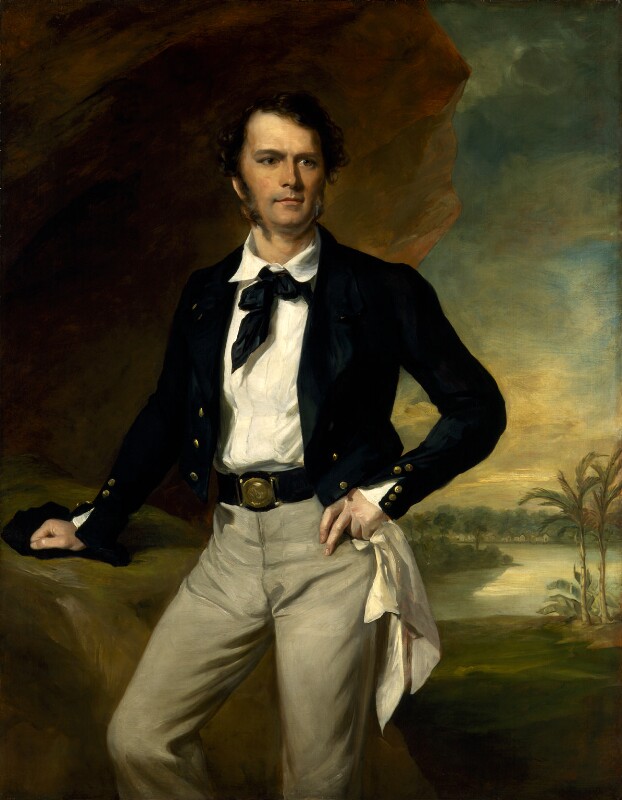



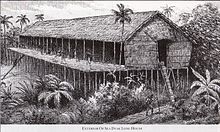

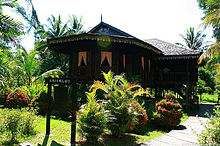







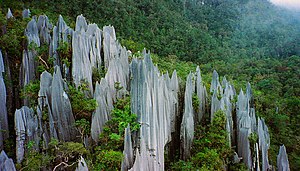
No comments:
Post a Comment